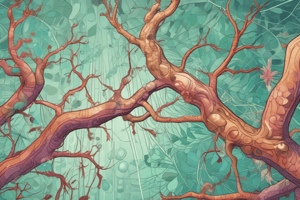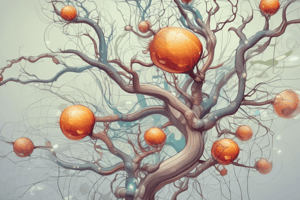Podcast
Questions and Answers
Which branch of biology is concerned with the study of microorganisms?
Which branch of biology is concerned with the study of microorganisms?
- Zoology
- Botany
- Microbiology (correct)
- Ecology
What is the process by which cells generate energy from glucose?
What is the process by which cells generate energy from glucose?
- Respiration (correct)
- Mitosis
- Cell division
- Photosynthesis
What is the term for the thin layer of lipid and protein molecules that surrounds the cell?
What is the term for the thin layer of lipid and protein molecules that surrounds the cell?
- Cytoplasm
- Mitochondria
- Cell membrane (correct)
- Nucleus
What is the process by which individuals with favorable traits are more likely to survive and reproduce?
What is the process by which individuals with favorable traits are more likely to survive and reproduce?
What is the model that describes the structure of DNA?
What is the model that describes the structure of DNA?
What is the term for the study of the relationships between organisms and their environment?
What is the term for the study of the relationships between organisms and their environment?
Study Notes
Branches of Biology
- Botany: Study of plants, including their structure, growth, evolution, classification, and distribution.
- Zoology: Study of animals, including their structure, behavior, evolution, classification, and distribution.
- Microbiology: Study of microorganisms, including bacteria, viruses, and other microorganisms.
- Ecology: Study of the relationships between organisms and their environment.
Cell Biology
- Cell structure:
- Cell membrane: thin layer of lipid and protein molecules
- Cytoplasm: jelly-like substance inside the cell membrane
- Nucleus: control center of the cell
- Mitochondria: energy-producing organelles
- Cellular processes:
- Photosynthesis: process by which plants convert light energy into chemical energy
- Respiration: process by which cells generate energy from glucose
- Mitosis: process of cell division
Genetics
- Mendel's Laws:
- Law of Segregation: each trait is determined by two alleles
- Law of Independent Assortment: alleles for different traits are sorted independently
- DNA structure:
- Double helix model: two strands of nucleotides twisted together
- Nucleotides: building blocks of DNA, consisting of sugar, phosphate, and base
- Genetic inheritance:
- Dominant and recessive alleles
- Inheritance patterns: autosomal dominant, autosomal recessive, X-linked
Evolution
- Mechanisms of evolution:
- Natural selection: process by which individuals with favorable traits are more likely to survive and reproduce
- Genetic drift: random change in allele frequency
- Gene flow: movement of alleles from one population to another
- Evidence for evolution:
- Fossil record: sequence of fossilized organisms shows gradual changes over time
- Comparative anatomy: similarities and differences in body structures across species
- Molecular biology: similarities and differences in DNA and protein sequences across species
Branches of Biology
- Botany is the study of plants, covering their structure, growth, evolution, classification, and distribution.
- Zoology is the study of animals, including their structure, behavior, evolution, classification, and distribution.
- Microbiology focuses on microorganisms, such as bacteria, viruses, and other microorganisms.
- Ecology examines the relationships between organisms and their environment.
Cell Biology
Cell Structure
- The cell membrane is a thin layer of lipid and protein molecules.
- Cytoplasm is a jelly-like substance inside the cell membrane.
- The nucleus is the control center of the cell.
- Mitochondria are energy-producing organelles.
Cellular Processes
- Photosynthesis is the process by which plants convert light energy into chemical energy.
- Respiration is the process by which cells generate energy from glucose.
- Mitosis is the process of cell division.
Genetics
Mendel's Laws
- The Law of Segregation states that each trait is determined by two alleles.
- The Law of Independent Assortment states that alleles for different traits are sorted independently.
DNA Structure
- The double helix model consists of two strands of nucleotides twisted together.
- Nucleotides are the building blocks of DNA, consisting of sugar, phosphate, and base.
Genetic Inheritance
- Dominant and recessive alleles determine the expression of traits.
- Inheritance patterns include autosomal dominant, autosomal recessive, and X-linked.
Evolution
Mechanisms of Evolution
- Natural selection is the process by which individuals with favorable traits are more likely to survive and reproduce.
- Genetic drift is a random change in allele frequency.
- Gene flow is the movement of alleles from one population to another.
Evidence for Evolution
- The fossil record shows a sequence of fossilized organisms with gradual changes over time.
- Comparative anatomy reveals similarities and differences in body structures across species.
- Molecular biology shows similarities and differences in DNA and protein sequences across species.
Studying That Suits You
Use AI to generate personalized quizzes and flashcards to suit your learning preferences.
Description
Learn about the different branches of biology, including botany, zoology, microbiology, and ecology, as well as the basics of cell structure and function.




